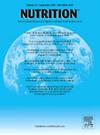波兰社区病人虚弱、营养不良和慢性病之间的关系
IF 3.2
3区 医学
Q2 NUTRITION & DIETETICS
引用次数: 0
摘要
背景:虚弱和营养不良严重影响着老年人的幸福感和生活质量。了解虚弱、营养状况和慢性疾病如何相互关联是设计个性化预防和干预方法的基础。目的分析参加“健康黄金年”计划的老年人体质、营养状况及相关社会人口学和临床因素之间的关系。方法:这项横断面研究涉及727名来自波兰Wrocław的65-100岁的社区居民。使用经过验证的工具评估营养状况(迷你营养评估,MNA)和虚弱程度(蒂尔堡虚弱指数,TFI)。采用Logistic回归和相关分析探讨变量之间的关联。进行受试者工作特征(ROC)曲线分析,以确定营养不良的关键预测因素。结果营养不良或营养不良风险在严重虚弱的参与者中最为普遍(p <;0.001)。Logistic回归鉴定BMI低(≤23.9 kg/m²;OR = 2.96, 95% CI: 1.89-4.63)、多药(每日用药≥3次;OR = 2.40, 95% CI: 1.59-3.62)和虚弱(TFI≥7;OR = 3.77, 95% CI: 2.45-5.80)是营养不良风险的重要预测因子。ROC分析显示,TFI评分对营养不良的预测准确率最高(AUC = 0.71, 95% CI: 0.66-0.75)。结论老年人营养不良与体弱多病、低BMI和多药相关。这些发现强调需要进行综合筛查和有针对性的干预,以减轻老年人的营养风险和改善结果。本文章由计算机程序翻译,如有差异,请以英文原文为准。
Association between frailty, malnutrition, and chronic diseases in community-based patients in Poland
Background
Frailty and malnutrition significantly impact the well-being and quality of life of the aging population. Understanding how frailty, nutritional condition, and chronic diseases correlate with each other is fundamental for designing individualized prevention and intervention methods.
Objectives
To analyze the relationships between frailty, nutritional status, and associated sociodemographic and clinical factors in older individuals participating in the “Golden Years in Health” program.
Methods
This cross-sectional study involved 727 community-dwelling adults aged 65–100 years from Wrocław, Poland. Validated tools were used to assess nutritional status (Mini Nutritional Assessment, MNA) and frailty (Tilburg Frailty Indicator, TFI). Logistic regression and correlation analyses were employed to explore associations between variables. Receiver Operating Characteristic (ROC) curve analysis was conducted to identify key predictors of malnutrition.
Results
Malnutrition or risk of malnutrition was most prevalent among participants with severe frailty (p < 0.001). Logistic regression identified low BMI (≤23.9 kg/m²; OR = 2.96, 95% CI: 1.89–4.63), polypharmacy (≥3 medications daily; OR = 2.40, 95% CI: 1.59–3.62), and frailty (TFI ≥7; OR = 3.77, 95% CI: 2.45–5.80) as significant predictors of malnutrition risk. ROC analysis indicated that the TFI score had the highest predictive accuracy for malnutrition (AUC = 0.71, 95% CI: 0.66–0.75).
Conclusions
Frailty, low BMI, and polypharmacy are strongly associated with malnutrition in older adults. These findings underscore the need for integrated screening and targeted interventions to mitigate nutritional risk and improve outcomes in aging populations.
求助全文
通过发布文献求助,成功后即可免费获取论文全文。
去求助
来源期刊

Nutrition
医学-营养学
CiteScore
7.80
自引率
2.30%
发文量
300
审稿时长
60 days
期刊介绍:
Nutrition has an open access mirror journal Nutrition: X, sharing the same aims and scope, editorial team, submission system and rigorous peer review.
Founded by Michael M. Meguid in the early 1980''s, Nutrition presents advances in nutrition research and science, informs its readers on new and advancing technologies and data in clinical nutrition practice, encourages the application of outcomes research and meta-analyses to problems in patient-related nutrition; and seeks to help clarify and set the research, policy and practice agenda for nutrition science to enhance human well-being in the years ahead.
 求助内容:
求助内容: 应助结果提醒方式:
应助结果提醒方式:


